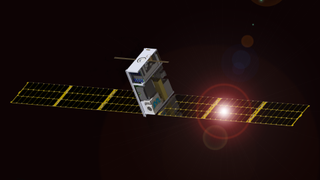NASA's Artemis 1 moon mission will carry 2 water-seeking cubesats
Their research could be crucial for future crewed missions to the moon.

When Artemis 1 launches, hopefully on Aug. 29, its primary mission is simple: test the brand new Space Launch System (SLS) rocket, the Orion spacecraft, and the ground systems at Kennedy Space Center in Florida. NASA hopes that this combination of technology will see humans return to the moon in a few years.
But that means Artemis 1 will be headed for the moon, an opportunity not to be missed, so it will be taking with it 10 secondary payloads. Two of those are cubesats designed to search the moon for water: Lunar IceCube and Lunar Polar Hydrogen Mapper (LunaH-Map). As humans return to the moon — and travel beyond — the discovery of water is crucial for long-duration missions, since would-be explorers hope to harvest breathable air and rocket fuel from the ice.
Lunar IceCube is being developed by Morehead State University in Kentucky. The 31-pound (14 kilograms) cubesat will carry a NASA instrument called the Broadband Infrared Compact High-Resolution Exploration Spectrometer (BIRCHES), which will map water on the lunar surface as well as in the exosphere, the thin layer of gas surrounding the moon like a very weak imitation of Earth's atmosphere.
Related: NASA's Artemis 1 moon mission explained in photos
"Lunar IceCube will help pave the way for human missions through significantly less expensive robotic missions and by addressing water dynamics on the moon," Mark Lupisella, a NASA exploration research and development manager, said in a statement. "This is not only important for science, but it could also be important for reducing the cost of human missions over the long-term."
The mission will also test a new ion propulsion thruster, which "operates electrically using small amounts of propellant to give a small push and drive the spacecraft along its path, similar to that of butterfly wings," according to NASA.
"Interplanetary exploration with CubeSats is possible through the use of innovative propulsion systems and creative trajectories," Benjamin Malphrus, executive director of the Space Science Center at Morehead State University, said in the statement. "The ion propulsion system is an enabling technology that will open the door to solar system exploration with small satellite platforms, ushering in a new era of space exploration."
Get the Space.com Newsletter
Breaking space news, the latest updates on rocket launches, skywatching events and more!
The Lunar Polar Hydrogen Mapper (LunaH-Map), on the other hand, will be studying previously identified potential areas of water ice at the moon's south pole. The 30-pound (13.6 kg) cubesat is being developed by Arizona State University.
"We know from previous missions there is an increased abundance of hydrogen at the lunar poles," Craig Hardgrove, a planetary geologist at Arizona State University and the mission's principal investigator, said in a statement. "But we don't know how much or exactly where."
During a planned 60-day mission, LunaH-Map will use two neutron spectrometers to map near-surface hydrogen deposits within the top 3 feet (1 meter) of the moon, including deposits in permanently shadowed regions. The result will be scientists' most detailed map of water ice at the south pole to date, according to NASA.
All the data gathered by Artemis 1's secondary payloads will contribute to future missions to the moon and beyond. NASA intends for Artemis 1 to kick off an ambitious lunar exploration program to build a sustainable presence on the moon.
"Anything we learn about the moon is valuable," Cliff Brambora, BIRCHES lead engineer said. "The moon is a kind of proving ground for technology and exploration, and the knowledge we gain there will help us with the potential for establishing a sustained presence on other planets, such as Mars."
Follow Stefanie Waldek on Twitter @StefanieWaldek. Follow us on Twitter @Spacedotcom and on Facebook.
Join our Space Forums to keep talking space on the latest missions, night sky and more! And if you have a news tip, correction or comment, let us know at: community@space.com.

Space.com contributing writer Stefanie Waldek is a self-taught space nerd and aviation geek who is passionate about all things spaceflight and astronomy. With a background in travel and design journalism, as well as a Bachelor of Arts degree from New York University, she specializes in the budding space tourism industry and Earth-based astrotourism. In her free time, you can find her watching rocket launches or looking up at the stars, wondering what is out there. Learn more about her work at www.stefaniewaldek.com.
